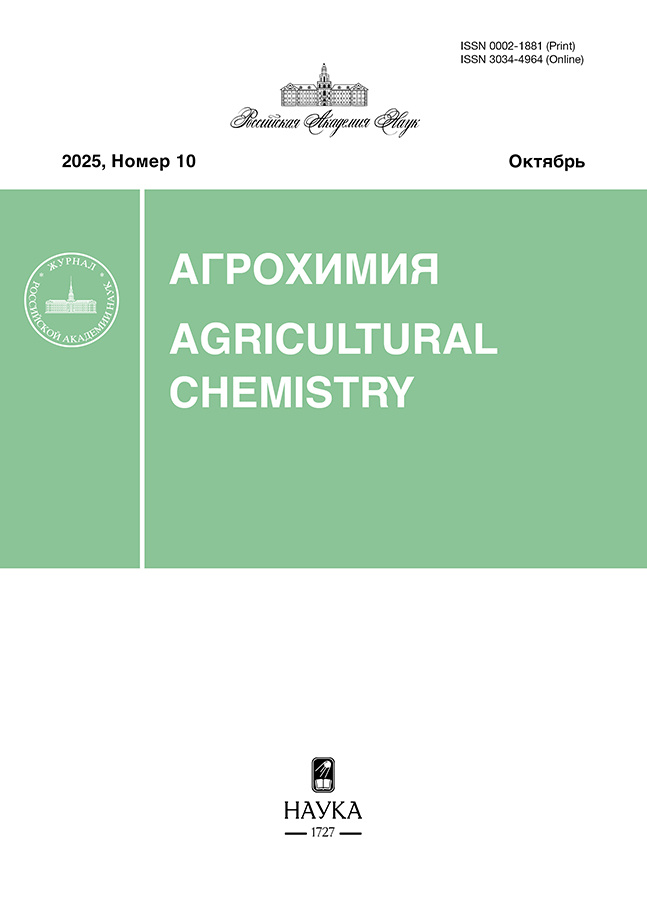EFFECT OF POTATO TREATMENT WITH TERPENOIDS WITH ANTIFUNGAL ACTIVITY ON THE MYCOBIOTA OF ITS LEAFS
- 作者: Shirokikh I.G.1, Bokov N.A.1, Khurshkainen T.V.2, Skripova N.N.2, Kolegova T.A.2, Shumova O.A.2, Chukicheva I.Y.2, Mokrushina S.E.1, Abubakirova R.I.1, Shirokikh A.A.1
-
隶属关系:
- Federal Agricultural Research Center of North-East named N.V. Rudnitsky
- Institute of Chemistry of the Komi Scientific Research Center of the Ural Branch of the RAS
- 期: 编号 10 (2025)
- 页面: 77-85
- 栏目: Agroecology
- URL: https://ruspoj.com/0002-1881/article/view/695484
- DOI: https://doi.org/10.7868/S3034496425100104
- ID: 695484
如何引用文章
详细
作者简介
I. Shirokikh
Federal Agricultural Research Center of North-East named N.V. Rudnitsky
Email: biotekhnologiya@fanc-sv.ru
ul. Lenina 166a, Kirov 610007, Russia
N. Bokov
Federal Agricultural Research Center of North-East named N.V. Rudnitskyul. Lenina 166a, Kirov 610007, Russia
T. Khurshkainen
Institute of Chemistry of the Komi Scientific Research Center of the Ural Branch of the RASul. Pervomaiskaya 48, Syktyvkar 167000, Russia
N. Skripova
Institute of Chemistry of the Komi Scientific Research Center of the Ural Branch of the RASul. Pervomaiskaya 48, Syktyvkar 167000, Russia
T. Kolegova
Institute of Chemistry of the Komi Scientific Research Center of the Ural Branch of the RASul. Pervomaiskaya 48, Syktyvkar 167000, Russia
O. Shumova
Institute of Chemistry of the Komi Scientific Research Center of the Ural Branch of the RASul. Pervomaiskaya 48, Syktyvkar 167000, Russia
I. Chukicheva
Institute of Chemistry of the Komi Scientific Research Center of the Ural Branch of the RASul. Pervomaiskaya 48, Syktyvkar 167000, Russia
S. Mokrushina
Federal Agricultural Research Center of North-East named N.V. Rudnitskyul. Lenina 166a, Kirov 610007, Russia
R. Abubakirova
Federal Agricultural Research Center of North-East named N.V. Rudnitskyul. Lenina 166a, Kirov 610007, Russia
A. Shirokikh
Federal Agricultural Research Center of North-East named N.V. Rudnitskyul. Lenina 166a, Kirov 610007, Russia
参考
- Klavins L., Almonaityte K., Salaseviciene A., Zommere A., Spalvis K., Vincevica-Gaile Z., Korpinen R., Klavins M. Strategy of coniferous needle biorefinery into value-added products to implement circular bioeconomy concepts in forestry side stream utilization // Molecules. 2023. V. 28. № 20.
- Семенов А.А. Очерк химии природных соединений. Новосибирск: Наука, Сибир. изд. фирма РАН, 2000. 664 с.
- Hurshkainen T.V., Kutchin A.V. Technology for obtaining of biopreparations and investigation of their effectiveness // Chemistry and technology of plant substances: Chemical and biochemical aspects. N.Y.: Apple Academic Press, 2017. P. 227–241.
- Chukicheva I.Yu., Hurshkainen T.V., Kutchin A.V. Natural plant growth regulators from coniferous raw materials // Innovat. Expert Exam. 2018. № 3(24). Р. 93–99.
- Hurshkainen T.V., Nikonova N.N., Nazarova Y.I., Shirokikh A.A., Bokov N.A., Shirokikh I.G., Kuchin A.V. Study of biocidal properties in extractive substances from coniferous wood greenery // Химия раст. сырья. 2025. № 1.
- Nikonova N.N., Hurshkainen T.V., Shevchenko O.G., Kuchin A.V. “Green technology” processing of pine (Pinus sylvestris L.) and larch (Larix sibirica Ledeb.) wood greenery to produce bioactive extracts // Holzforschung. 2022. V. 76. № 3. P. 276–284.
- Murashige T., Skoog F. A revised medium for rapid growth and bio assays with tobacco tissue cultures // Physiol. Plant. 1962. V. 15. № 3. P. 473.
- Pinaev A.G., Kichko A.A., Aksenova T.S., Safronova V.I., Kozhenkova E.V., Andronov E.E. RIAM: A universal accessible protocol for the isolation of high purity DNA from various soils and other humic substances // Methods and Protocols. 2022. V. 5. № 6. P. 99.
- Bolyen E., Rideout J.R., Dillon M.R., Bokulich N.A., Abnet C.C., Al-Ghalith G.A. Reproducible, interactive, scalable and extensible microbiome data science using QIIME 2 // Nat. Biotechnol. 2019. V. 37. P. 852–857.
- Мэгарран Э. Экологическое разнообразие и его измерение. М.: Мир, 1992. 181 с.
- Bardou P., Mariette J., Escudié F., Djemiel C., Klopp C. Jvenn: an interactive Venn diagram viewer // BMC Bioinform. 2014. V. 15. № 293.
- Nguyen N.H., Song Z., Bates S.T., Branco S., Tedersoo L., Menke J., Schilling J.S., Kennedy P.G. FUNGuild: an open annotation tool for parsing fungal community datasets by ecological guild // Fungal Еcol. 2016. V. 20. P. 241–248.
- Ryan M.C., Stucky M., Wakefield C., Melott J.M., Akbani R., Weinstein J.N., Broom B.M. Interactive clustered heat map builder: An easy web-based tool for creating sophisticated clustered heat maps // F1000Research. 2019. V. 8.
- Кичко А.А., Аксенова Т.С., Шапкин В.М., Зверев А.О., Хютти А.В., Андронов Е.Е. Анализ микобиоты в пораженных листьях картофеля (Solanum Tuberosum L.) с использованием метагеномных подходов // Сел.-хоз. биол. 2019. Т. 54. № 5. С. 990–1001.
- Кокаева Л.Ю., Хуснетдинова Т.И., Березов Ю.И., Балабко П.Н., Еланский С.Н. Видовой состав грибов, ассоциированных с листьями картофеля // Защита картофеля. 2017. № 2. С. 8–11.
- Yang H., Ye W., Ma J., Zeng D., Rong Z., Xu M., Wang Y., Zheng X. Endophytic fungal communities associated with field-grown soybean roots and seeds in the Huang-Huai region of China // Peer J. 2018. V. 6. e4713.
- Шитиков В.К., Розенберг Г.С. Оценка биоразнообразия: попытка формального обобщения // Количественные методы экологии и гидробиологии (сб. науч. тр., посвящ. памяти А.И. Баканова). Тольятти: СамНЦ РАН, 2005. С. 91–129.
- Экологический энциклопедический словарь / Под ред. И.И. Дедю. Кишинев: Гл. ред. Молд. сов. энцикл., 1989. 406 с.
- Кинтя П.К., Фадеев Ю.М., Акимов Ю.А. Терпеноиды растений. Кишинев: Штиница, 1990. 150 с.
- Дзюркевич М.С., Файзуллин Д.А., Зуев Ю.Ф., Стойков И.И., Племенков В.В. Синтез амфифильных имидов на основе монотерпенов и изучение их взаимодействия с модельными биомембранами // Тез. докл. кластера конф. по орг. химии “ОргХим-2013”. СПб., 2013. С. 368.
补充文件









